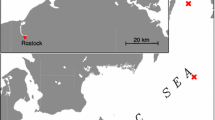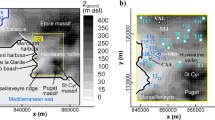Abstract
The inland and offshore propagation speeds of a sea breeze circulation cell are simulated using a three-dimensional hydrostatic model within a terrain-following coordinate system. The model includes a third-order semi-Lagrangian advection scheme, which compares well in a one-dimensional stand-alone test with the more complex Bott and Smolarkiewicz advection schemes. Two turbulence schemes are available: a local scheme by Louis (1979) and a modified non-local scheme based on Zhang and Anthes (1982). Both compare well with higher-order closure schemes using the Wangara data set for Day 33–34 (Clark et al., 1971).
Two-dimensional cross-sections derived from airborne sea breeze measurements (Finkele et al. 1995) constitute the basis for comparison with two-dimensional numerical model results. The offshore sea breeze propagation speed is defined as the speed at which the seaward extent of the sea breeze grows offshore. On a study day, the offshore sea breeze propagation speed, from both measurements and model, is -3.4 m s-1. The measured inland propagation speed of the sea breeze decreased somewhat during the day. The model results show a fairly uniform inland propagation speed of 1.6 m s-1 which corresponds to the average measured value. The offshore sea breeze propagation speed is about twice the inland propagation speed for this particular case study, from both the model and measurements.
The influence of the offshore geostrophic wind on the sea breeze evolution, offshore extent and inland penetration are investigated. For moderate offshore geostrophic winds (-5.0 m s-1), the offshore and inland propagation speeds are non-uniform. The offshore extent in moderate geostrophic wind conditions is similar to the offshore extent in light wind conditions (-2.5 m s-1). The inland extent is greater in light offshore geostrophic winds than in moderate ones. This suggests that the offshore extent of the sea breeze is less sensitive to the offshore geostrophic wind than its inland extent. However, these results hold only if it is possible to define an inland propagation speed. For stronger offshore geostrophic winds (-7.5 m s-1), the sea breeze is completely offshore and the inland propagation speed is ill-defined.
Similar content being viewed by others

References
Abbs, D. J.: 1986, 'Sea-Breeze Interactions along a Concave Coastline in Southern Australia: Observations and Numerical Modeling Study', Mon. Wea. Rev. 114, 831-848.
André, J. C., DeMoor, G., Lacarrére, P., Therry, G., and DuVachat, R.: 1978, 'Modelling the 24-Hour Evolution of the Planetary Boundary Layer', J. Atmos. Sci. 35, 1861-1883.
Anthes, R. A., Hsie, E.-Y., and Kuo, Y.-H.: 1987, Description of the Penn State/NCAR Mesoscale Model Version 4 (MM4), NCAR/TN-282+STR, Boulder, CO, 66 pp.
Arritt, R.W.: 1987, 'The Effect of Water Surface Temperature on Lake Breezes and Thermal Internal Boundary Layers', Boundary-Layer Meteorol. 40, 101-125.
Arritt, R. W.: 1989, 'Numerical Modelling of the Offshore Extent of Sea Breezes', Quart. J. Roy. Meteorol. Soc. 115, 547-570.
Arritt, R. W.: 1993, 'Effects of the Large-Scale Flow on Characteristic Features of the Sea Breeze', J. Appl. Meteor. 32, 116-225.
Atkinson, B. W.: 1981, Meso-scale Atmospheric Circulations, Academic Press, London, 495 pp.
Banta, R. M., Olivier, L. D., and Levinson, D. H.: 1993, 'Evolution of the Monterey Bay Sea-Breeze Layer As Observed by Pulsed Doppler Lidar', J. Atmos. Sci. 50, 3959-3982.
Bates, J. R., Semazzi, F. H. M., Higgins, R. W., and Barros, S. R. M.: 1990, 'Integration of the Shallow Water Equations on the Sphere Using a Vector Semi-Lagrangian Scheme with a Multigrid Solver', Mon. Wea. Rev. 118, 1615-1627.
Bechtold, P., Pinty, J.-P., and Mascart, P.: 1991, 'A Numerical Investigation of the Influence of Large-Scale Winds on Sea-Breeze-and Inland-Breeze-type Circulations', J. Appl. Meteorol. 30, 1268-1279.
Berge, E. and Kristjánsson, J. E.: 1992, 'Numerical Weather Simulations with Different Formulations for the Advection of Humidity and Cloud Water', Mon. Wea. Rev. 120, 1583-1602.
Blackadar, A. K.: 1976, 'Modelling the Nocturnal Boundary Layer', Third Symposium on Atmospheric Turbulence, Diffusion and Air Quality, Rayleigh, Amer. Meteor. Soc., pp. 46-49.
Blackadar, A. K.: 1978, 'Modelling Pollutant Transfer During Daytime Convection', Reprints, Fourth Symp. on Atmospheric Turbulence, Diffusion and Air Quality, Reno, Amer. Meteor. Soc., pp. 443-447.
Born, K.: 1989, FOOT Ein Dreischichtenmodell auf der Basis von REWIMET zur Simulation der dynamischen Grenzschicht, M.Sc. Thesis, University of Bonn, 139 pp.
Clark, R. H., Dyer, A. J., Brook, P. R., Reid, D. G., and Troup, A. J.: 1971, The Wangara Experiment: Boundary Layer Data, Technical Paper 19, CSIRO Division of Atmospheric Research, Mordialloc, 340 pp.
Charnock, H.: 1955, 'Wind Stress on a Water Surface', Quart. J. Roy. Meteorol. Soc. 81,639-640.
Deardorff, J. W.: 1974, 'Three-Dimensional Numerical Study of the Height and Mean Structure of a Heated Planetary Boundary Layer', Boundary-Layer Meteorol. 7, 81-106.
Estoque, M. A.: 1962, 'The Sea Breeze as a Function of the Prevailing Synoptic Situation', J. Atmos. Sci. 19, 244-250.
Finkele, K.: 1994, Numerical Simulations and Aircraft Measurements of Sea Breezes, Ph.D. Thesis, Flinders University, 150 pp.
Finkele, K., Hacker, J. M., Kraus, H., and Byron-Scott, R. A. D.: 1995, 'A Complete Sea Breeze Circulation Cell Derived from Aircraft Observations', Boundary-Layer Meteorol. 73, 299-317.
Grimmond C. S. B., Oke, T. R., and Cleugh, H. A.: 1993, 'The Role of “Rural” Incomparisons of Observed Suburban-Rural Flux Differences', Exchange processes at the land surface for a range of space and time scales, International Association of Hydrological Sciences Publication, 212, 165-174.
Hacker, J. M., Hartmann, J., Kraus, H., and Schwerdtfeger, P.: 1990, Airborne Measurements of the Structure of Sea-Breeze Fronts in Summer 1988/89. FIAMS Research Report 47, Flinders Institute for Atmospheric and Marine Sciences, Adelaide, 102 pp.
Klemp, J. B. and Lilly, D. K.: 1978, 'Numerical Simulation of Hydrostatic Mountain Waves', J. Atmos. Sci. 32, 78-107.
Kraus, H., Hacker, J. M., and Hartmann, J.: 1990, 'An Observational Aircraft-Based Study of Sea-Breeze Frontogenesis', Boundary-Layer Meteorol. 53, 223-265.
Louis, J.-F.: 1979, 'A Parametric Model of Vertical Eddy Fluxes in the Atmosphere', Boundary-Layer Meteorol. 17, 187-202.
Martin, C. L. and Pielke, R. A.: 1983, 'The Adequacy of the Hydrostatic Assumption in Sea Breeze Modeling over Flat Terrain', J. Atmos. Sci. 40, 1472-1481.
McGregor, J. L.: 1993, 'Economical Determination of Departure Points for Semi-Lagrangian Models', Mon. Wea. Rev. 121, 221-230.
National Research Council, 1992: Coastal Meteorology: A Review of the State of the Science. National Academy Press, Washington, DC, 99 pp.
Nicholls, M. E., Pielke, R. A., and Cotton, W. R.: 1991, 'A Two-Dimensional Numerical Investigation of the Interaction between Sea Breezes and Deep Convection over the Florida Peninsula', Mon. Wea. Rev. 119, 298-323.
Physick, W. L.: 1976, 'A Numerical Model of the Sea-Breeze Phenomenon over a Lake or Gulf', J. Atmos. Sci. 33, 2107-2135.
Physick, W. L.: 1980, 'Numerical Experiments on the Inland Penetration of the Sea Breeze', Quart. J. Roy. Meteorol. Soc. 106, 735-746.
Physick, W. L., Noonan, J. A., McGregor, J. L., Hurley, P. J., Abbs, D. J., and Manins, P. C.: 1994, LADM: A Lagrangian Atmospheric Dispersion Model, Technical Paper 24, CSIRO Division of Atmospheric Research, Mordialloc, 137 pp.
Pielke, R. A.: 1984, Mesoscale Meteorological Modelling, Academic Press, New York, 612 pp.
Schlünzen, K. H.: 1990, 'Numerical Studies on the Inland Penetration of Sea Breeze Fronts at a Coastline with Tidally Flooded Mudflats', Beitr. Phys. Atmosph. 63, 243-256.
Schlünzen, K. H. and Krell, U.: 1994, 'Mean and Local Transport in Air', in J. Sündermann (ed.), Circulation and Contaminant Fluxes in the North Sea, Springer, Berlin, pp. 317-344.
Simpson, J. E.: 1994, Sea Breeze and Local Winds, Cambridge University Press, Cambridge, 234 pp.
Simpson, J. E., Mansfield, D. A., and Milford, J. R.: 1977, 'Inland Penetration of Sea Breeze Fronts', Quart. J. Roy. Meteorol. Soc. 103, 47-76.
Yamada, T. and Mellor, G.: 1975, 'A Simulation of theWangara Atmospheric Boundary Layer Data', J. Atmos. Sci. 32, 2309-2329.
Yang, X.: 1991, 'A Study of nonhydrostatic Effects in Idealized Sea Breeze Systems', Boundary-Layer Meteorol. 54, 183-208.
Zhang, D.-L. and Anthes, R. A.: 1982, 'A High-Resolution Model of the Planetary Boundary Layer - Sensitivity Tests and Comparisons with SESAME-79 Data', J. Appl. Meteorol. 21, 1594-1609.
Author information
Authors and Affiliations
Rights and permissions
About this article
Cite this article
Finkele, K. Inland and Offshore Propagation Speeds of a Sea Breeze from Simulations and Measurements. Boundary-Layer Meteorology 87, 307–329 (1998). https://doi.org/10.1023/A:1001083913327
Issue Date:
DOI: https://doi.org/10.1023/A:1001083913327



